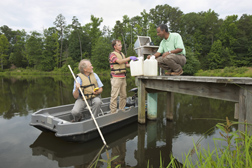This page has been archived and is being provided for reference purposes only. The page is no longer being updated, and therefore, links on the page may be invalid.
| Read the magazine story to find out more. |
|
|
|
|
Detecting Pathogens in Waterways: An Improved Approach
By Dennis O'BrienFebruary 8, 2011
U.S. Department of Agriculture (USDA) scientists have come up with a way to detect pathogenic Escherichia coli and Salmonella bacteria in waterways at lower levels than any previous method. Similar methods have been developed to detect pathogenic E. coli in meat products, but the approach by the scientists with USDA's Agricultural Research Service (ARS) represents a first for waterways.
ARS is USDA's principal intramural scientific research agency, and this research supports the USDA priority of ensuring food safety.
When health officials test a public beach or lake for Salmonella or E. coli 0157:H7, they use two types of non-pathogenic bacteria, Enterococci and generic E. coli, as indicators. But while the indicators are often detected in contaminated waterways, their abundance doesn't guarantee the presence of either pathogen, according to Michael Jenkins, a microbiologist at the ARS J. Phil Campbell Sr. Natural Resource Conservation Center in Watkinsville, Ga.
These indicator organisms are often reliable, but investigators have detected the indicators in pathogen-free waters and have failed to find them in waters that contained sufficient levels of the pathogens to make someone sick.
The indicators are used as signals because both pathogens are hard to detect directly at levels that will make someone ill: just 100 cells of Salmonella and just 10 to 100 cells of E. coli 0157:H7, the toxic strain of the bacterium. Organic matter in a water sample will throw off current PCR (polymerase chain reaction) technology when it is used as a tool for detection. Salmonella and E. coli outbreaks are often attributed to agricultural operations, so improving ways to track down sources of outbreaks is a major priority.
Jenkins and his ARS colleagues Dinku Endale and Dwight Fisher at Watkinsville combined techniques previously developed to assess water quality and detect pathogens in laboratory settings: a water filtration technique to concentrate the pathogens; a special medium for growing and measuring the number of pathogenic cells; a biochemical testing process; and PCR technology.
They collected water samples from a pond at the Watkinsville site, ran them through a special filter, removed the filter contents and used a centrifuge to spin the filtered contents into a pellet form. They used the suspended pellets to develop cell cultures, confirmed their identity with a genetic method, and determined the concentration found in the original samples.
Their results, published in the Journal of Applied Microbiology, showed the process can be used to detect just a few cells of pathogenic E. coli and Salmonella in a 10-liter water sample, lower levels than any previously detected. Because the system involves collecting cell cultures, it also may lead to developing culture collections that-like a fingerprint database-could be used to identify bacterial strains that are potential sources of future outbreaks.
Read more about this research in the February 2011 issue of Agricultural Research magazine.

